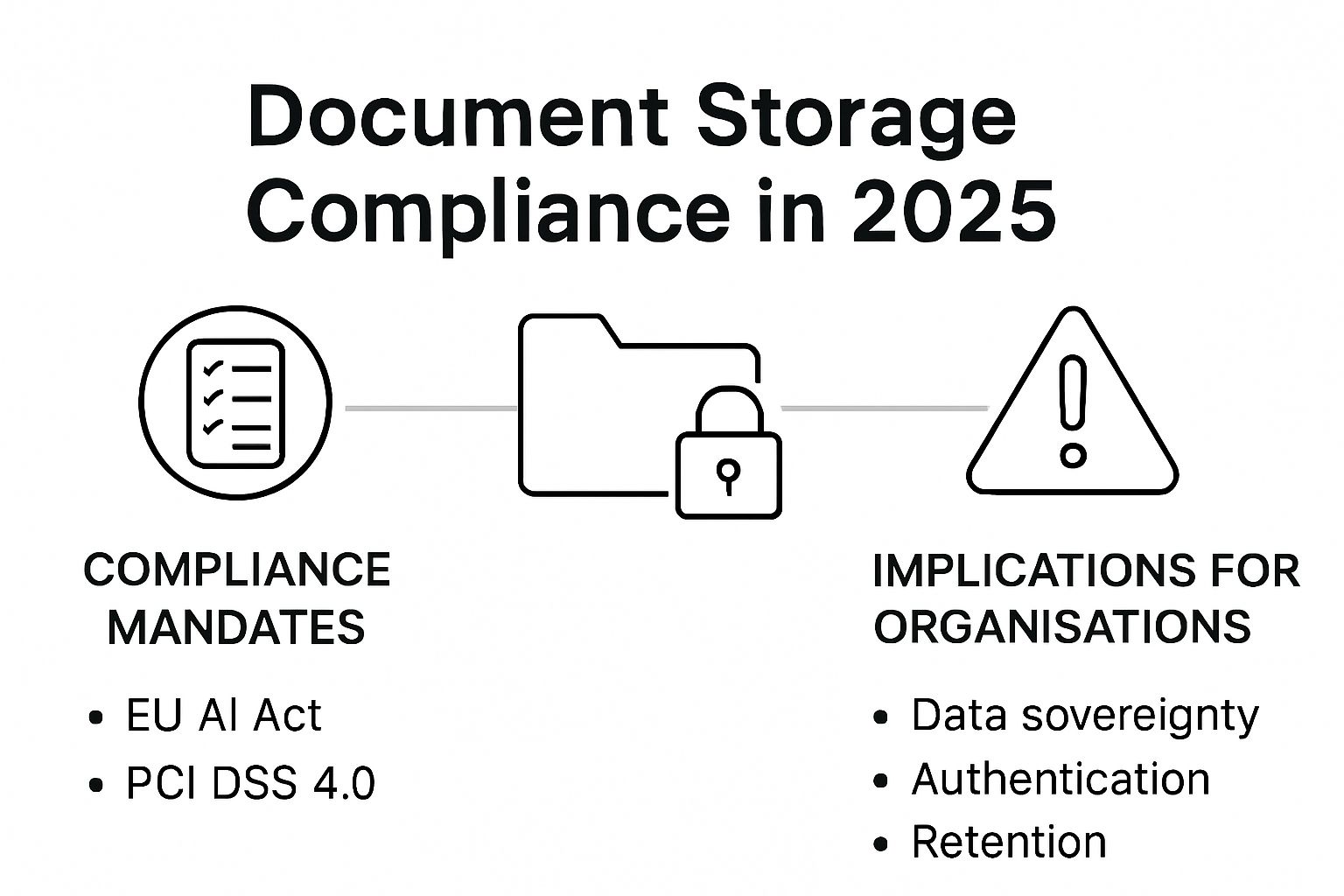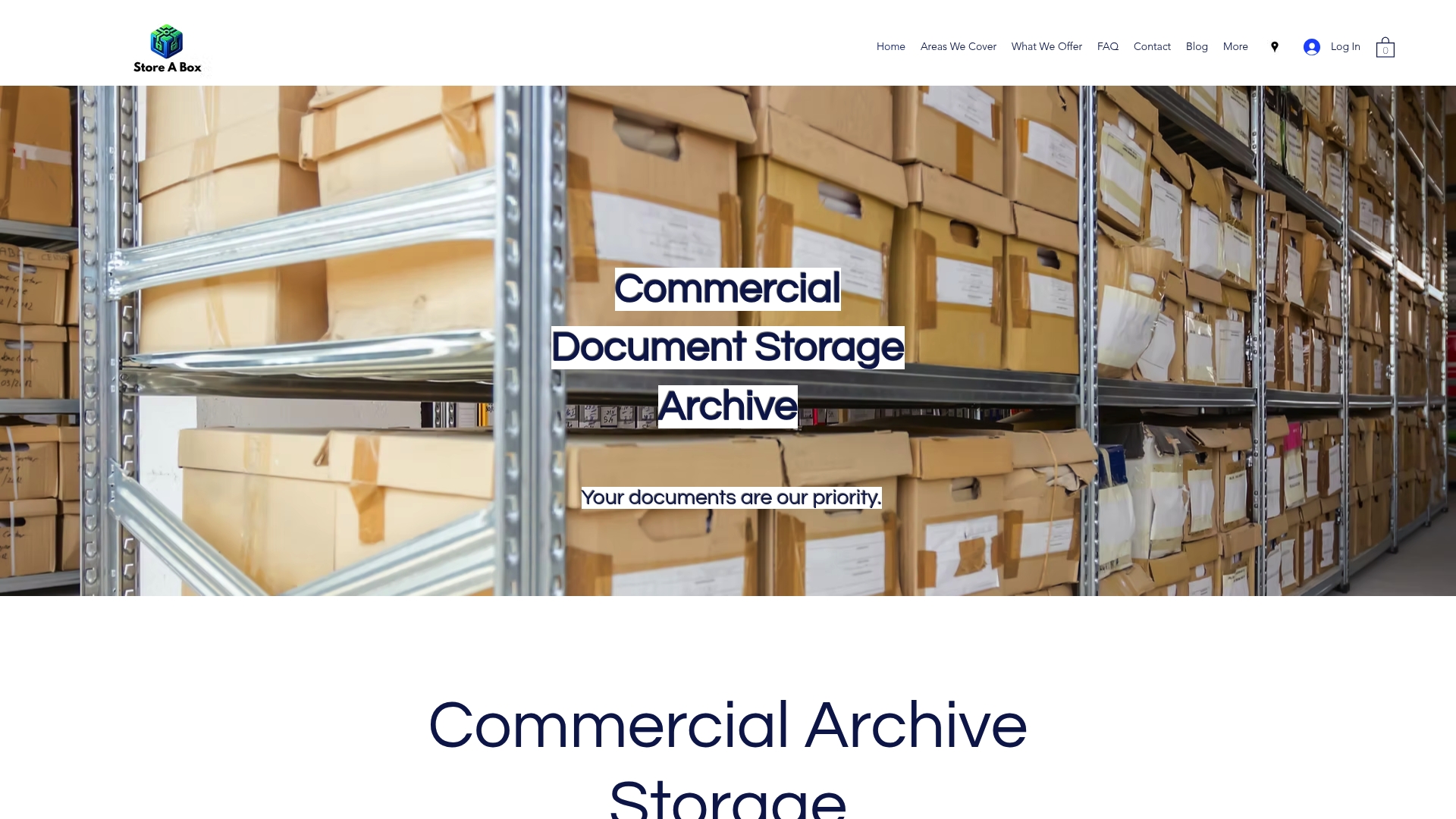Document Storage Compliance in 2025: A Guide for Legal and Finance Leaders
- Natalie Stephens
- Jun 5, 2025
- 8 min read
Document storage compliance is entering a new era, and legal as well as finance departments are under more pressure than ever. Think compliance is just about storing files securely? Not quite. With the EU AI Act and PCI DSS 4.0 setting fresh standards, by March 2025, organisations must meet some of the strictest data protection requirements yet. But here is the real shocker. The biggest risk is not outdated technology, but people leaving loopholes in access and retention – and that catch is putting even the most robust systems at risk.
Table of Contents
Quick Summary
Key Regulatory Requirements for Document Storage
Document storage compliance has become increasingly complex as regulatory frameworks evolve to protect sensitive information and ensure data integrity. Organizations must navigate a multifaceted landscape of legal requirements that demand meticulous attention to detail and robust management strategies.
Data Protection and Privacy Standards
The regulatory environment for document storage is fundamentally shaped by stringent data protection frameworks. By 2025, organizations will face increasingly rigorous compliance mandates that extend far beyond traditional record-keeping practices. The EU AI Act represents a critical milestone, introducing comprehensive restrictions on AI-powered document management systems. This legislation specifically prohibits unacceptable-risk AI uses, including manipulative techniques and unauthorized biometric surveillance.
Key compliance requirements now encompass multiple critical dimensions:
- Data Sovereignty
: Organizations must store and process personal information within specific geographic boundaries
- Authentication Protocols
: Implementing multi-factor authentication for document access
- Retention Management
: Establishing clear guidelines for document lifecycle and secure disposal
Sector-Specific Regulatory Frameworks

Different industries face unique document storage compliance challenges. Financial services and healthcare sectors experience particularly stringent regulations. The PCI DSS 4.0 standards will be fully enforced by March 31, 2025, mandating more sophisticated document management approaches. These requirements include extended log retention periods and risk-based flexibility for systems handling sensitive payment card information.
Legal and finance professionals must develop comprehensive strategies that address:
Precise access control mechanisms
Encrypted storage solutions
Detailed audit trail documentation
Comprehensive risk assessment protocols
Technology and Compliance Integration
Successful document storage compliance demands more than procedural adherence. Organizations must invest in technological infrastructure that seamlessly integrates regulatory requirements with operational efficiency. Data sovereignty mandates now require organizations to implement geographically specific storage solutions that respect local legal boundaries while maintaining global operational capabilities.
The most effective compliance strategies will leverage advanced technologies that provide:
Real-time monitoring capabilities
Automated compliance reporting
Dynamic risk assessment tools
Secure, scalable document management systems
As regulatory landscapes continue to evolve, proactive adaptation becomes paramount. Organizations that view document storage compliance as a strategic opportunity rather than a bureaucratic burden will be best positioned to protect sensitive information and maintain operational excellence.
Navigating these complex requirements demands a holistic approach that combines technological innovation, strategic planning, and unwavering commitment to data protection principles.
Practical Steps for Achieving Compliance

Comprehensive Document Management Assessment
The foundation of effective compliance begins with a thorough assessment of existing document management practices. Document control best practices emphasize the critical importance of conducting regular document audits aligned with standards such as ISO 9001, FDA, and HIPAA. These audits help organizations identify potential compliance gaps and develop targeted improvement strategies.
Key assessment elements include:
- Current Storage Infrastructure
: Evaluate existing document storage systems and their alignment with regulatory requirements
- Access Control Mechanisms
: Review and analyse current authentication and permission protocols
- Documentation Workflows
: Map existing document creation, approval, and retention processes
Implementing Secure Document Management Systems
A centralized Document Management System (DMS) forms the backbone of modern compliance strategies. Strategic document management planning recommends implementing systems with robust security features and clear operational policies. This approach ensures organizations can effectively manage document lifecycles while maintaining strict regulatory adherence.
Critical implementation strategies include:
Role-based access controls
Comprehensive document versioning
Secure digital archiving
Automated compliance tracking
Continuous Compliance Monitoring and Training
Regulatory compliance is not a one-time achievement but an ongoing process requiring continuous attention and adaptation. Organizations must develop dynamic monitoring systems that can quickly respond to changing regulatory landscapes. This involves creating comprehensive training programmes that educate staff about compliance requirements and best practices.
Effective monitoring approaches encompass:
Regular compliance audits
Real-time documentation tracking
Periodic staff training sessions
Automated compliance reporting mechanisms
Successful document storage compliance demands a holistic approach that integrates technological solutions, strategic planning, and a culture of continuous improvement. By implementing these practical steps, organizations can develop resilient document management systems that protect sensitive information and maintain regulatory integrity.
The most effective compliance strategies will view regulatory requirements not as bureaucratic obstacles but as opportunities to enhance organizational efficiency and data protection capabilities.
Secure Document Storage Solutions for 2025
Document storage solutions in 2025 represent a sophisticated convergence of advanced technology, robust security protocols, and adaptive compliance mechanisms. Organizations must strategically select storage platforms that not only protect sensitive information but also provide seamless operational flexibility.
Cloud-Native Storage Architecture
Document management trends indicate a significant shift towards cloud-native storage solutions that offer unprecedented scalability and security. By 2025, most organizations will leverage cloud platforms that provide integrated compliance features and advanced security measures. These systems go beyond traditional storage models, enabling real-time collaboration while maintaining stringent data protection standards.
Key characteristics of modern cloud storage include:
- Scalable Infrastructure
: Dynamic resource allocation
- Geographic Redundancy
: Multiple data centre backups
- Automated Compliance Tracking
: Built-in regulatory monitoring
Advanced Security Protocols
Secure cloud document storage solutions will incorporate multi-layered security frameworks designed to protect against evolving cybersecurity threats. Advanced encryption technologies, multi-factor authentication, and intelligent access control mechanisms will become standard features rather than optional enhancements.
Critical security components will include:

End-to-end encryption
Comprehensive user authentication
Real-time threat detection
Granular permission management
Hybrid Storage Strategies
Recognizing the diverse needs of different organizations, hybrid document storage solutions will emerge as a sophisticated alternative to purely cloud-based systems. These platforms will offer flexible architectures that balance on-premises security with cloud-based accessibility, allowing businesses to customize their storage approach based on specific regulatory and operational requirements.
Hybrid storage strategies will provide:
Seamless integration between local and cloud systems
Customizable security protocols
Enhanced data sovereignty controls
Flexible compliance adaptation
The future of document storage extends far beyond simple data retention. Modern solutions represent intelligent ecosystems that actively protect, manage, and optimize organizational information. By embracing these advanced technologies, legal and finance leaders can transform document storage from a passive administrative function into a strategic operational advantage.
Successful implementation demands a proactive approach that views document storage not as a technical challenge but as a critical component of organizational resilience and strategic capability.
Common Mistakes and How to Avoid Them
Document storage compliance requires meticulous attention to detail. Even well-intentioned organizations can inadvertently expose themselves to significant risks through seemingly minor oversights. Understanding and proactively addressing common mistakes is crucial for maintaining robust document management strategies.
Inadequate Access Control Mechanisms
Records management best practices emphasize the critical importance of implementing strict access controls. Many organizations underestimate the potential damage caused by unrestricted document access. Weak authentication protocols can lead to unauthorized data exposure, compliance violations, and potential security breaches.
Common access control mistakes include:
- Overly Broad Permissions
: Granting unnecessary document access to multiple employees
- Inconsistent User Management
: Failing to update access rights when staff roles change
- Weak Authentication
: Relying on simple password systems

Poor Document Retention Strategies
Document storage policies are fundamental to maintaining compliance and operational efficiency. Many organizations struggle with inappropriate document retention practices that can result in legal vulnerabilities or unnecessary storage costs. Developing a comprehensive document retention policy requires careful consideration of industry-specific regulations and organizational needs.
Key retention strategy pitfalls include:
Keeping documents beyond required retention periods
Inconsistent deletion protocols
Lack of systematic document lifecycle management
Failing to account for different document types
Overlooking Technology and Training Integration
Compliance is not solely a technological challenge but also a human one. Organizations frequently make the mistake of implementing advanced document management systems without providing adequate staff training. This disconnect can render even the most sophisticated storage solutions ineffective.
Critical training and technology integration challenges include:
Insufficient staff education on compliance requirements
Failure to communicate new document management protocols
Neglecting ongoing training and skill development
Resisting technological adaptation
Addressing these common mistakes requires a holistic approach that combines technological solutions, clear policies, and continuous staff education. Organizations must view document storage compliance as an ongoing process of improvement rather than a static checklist.
Successful document management demands proactive risk mitigation, continuous learning, and a commitment to maintaining the highest standards of data protection and regulatory adherence. By identifying and addressing potential vulnerabilities, organizations can transform compliance from a potential liability into a strategic advantage.
The most effective document storage strategies recognize that prevention is invariably more cost-effective and less disruptive than addressing compliance failures after they occur.
Frequently Asked Questions
What are the key regulatory requirements for document storage compliance in 2025?
Organisations must adhere to stringent data protection frameworks such as the EU AI Act and PCI DSS 4.0, focusing on data sovereignty, multi-factor authentication, and clear document retention guidelines.
How can organisations ensure compliance with document management practices?
Regular audits aligned with standards like ISO 9001, implementing secure Document Management Systems (DMS) with role-based access, and continuous training of staff are crucial for achieving compliance.
What are the common mistakes organisations make regarding document storage compliance?
Common mistakes include inadequate access controls, poor document retention strategies, and overlooking the importance of integrating technology with staff training, which can lead to compliance failures.
What document storage solutions are recommended for compliance in 2025?
Organisations should consider cloud-native storage architectures, hybrid storage strategies, and advanced security protocols, including end-to-end encryption and real-time monitoring to meet compliance requirements.
Stay Compliant and Stress-Free with Trusted Document Storage
Are you feeling the pressure as 2025 approaches with its complex new document storage compliance rules? The rise of strict frameworks like the EU AI Act and PCI DSS 4.0 means that overlooking even a small loophole in your document retention or access controls can put your entire organisation at risk. Legal and finance leaders know that robust data protection and regular audits are not just nice to have—they are now absolute necessities.
If navigating these new requirements feels overwhelming, you are not alone. Many leaders worry about gaps in their document security or about keeping up with evolving regulatory landscapes. With over 30 years of expertise, Store a box offers reliable, secure and friendly document storage and management services designed to meet the latest compliance standards. Whether you need help with confidential record storage, role-based access, or end-to-end security protocols, our team is here to support you locally and nationally, giving you peace of mind and commercial confidence.
Do not let last-minute compliance errors threaten your business. Take action today to ensure your sensitive documents are stored safely, securely and in full compliance with 2025 regulations. Visit Store a box now for a tailored solution that keeps your organisation protected and forward-thinking.



Comments